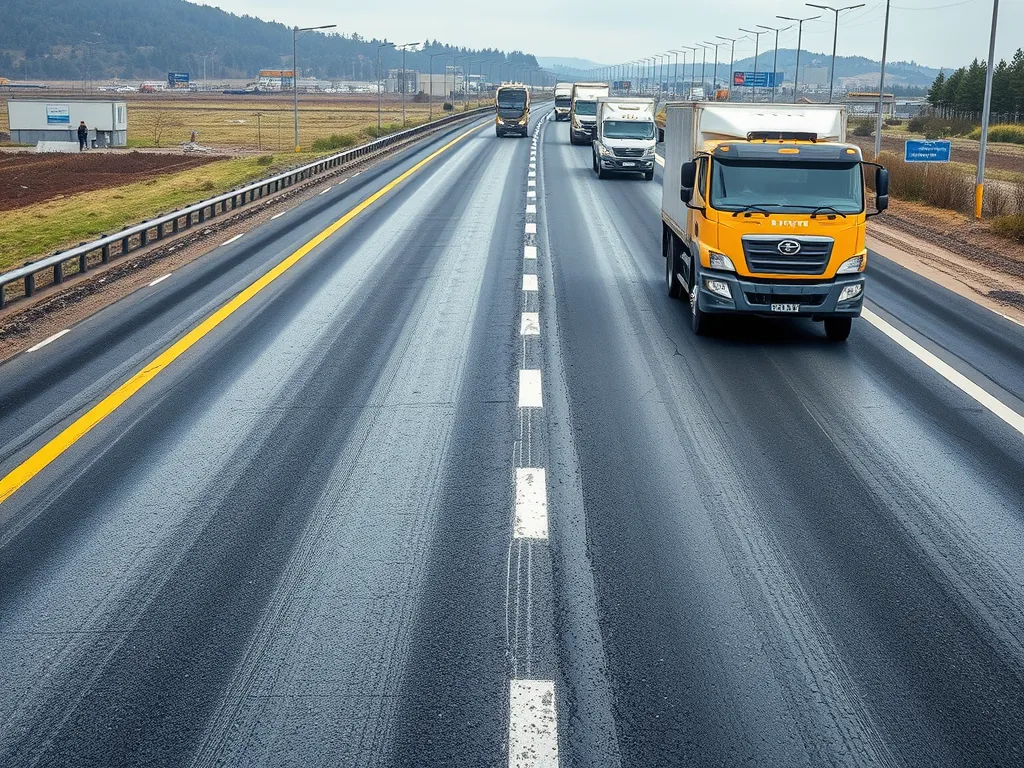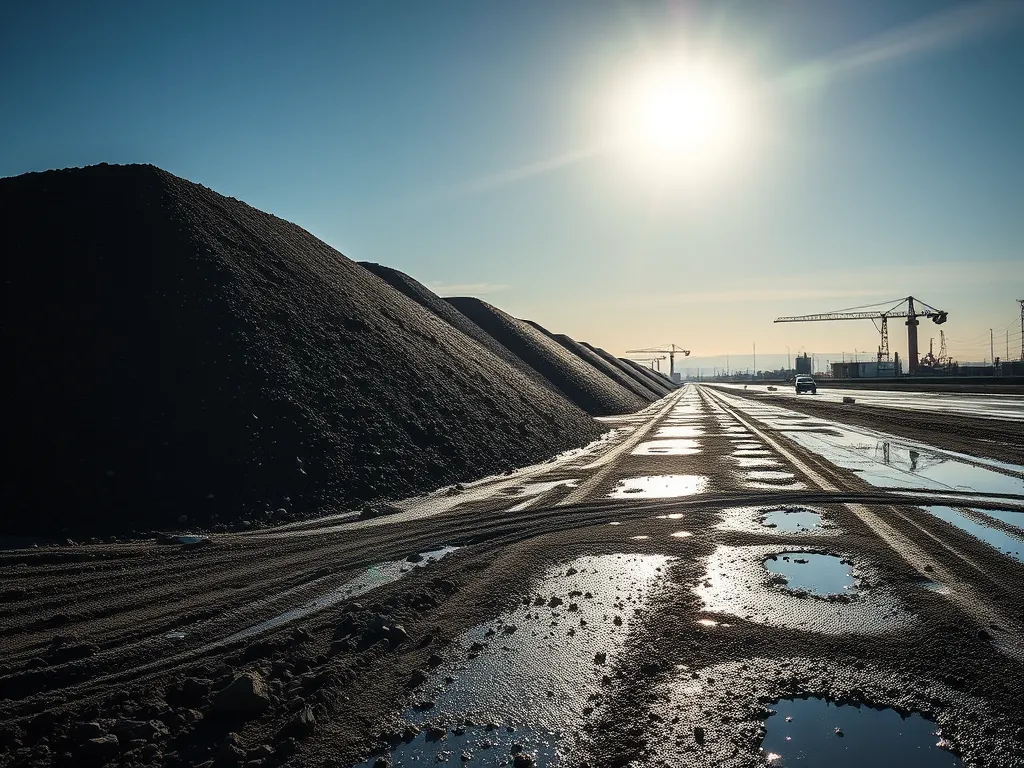Characteristics Of Cold Mix Asphalt: What Makes It Different?
Published on: October 9, 2025 | Last Updated: April 14, 2025
Written By: George Voss
Cold mix asphalt is a ready-to-use paving material containing crushed stone aggregates and bitumen emulsion – asphalt binder suspended in water. Unlike hot mix asphalt (HMA) requiring 300-350°F heating, it’s applied at ambient temperatures. Key characteristics include ½” maximum aggregate size, 400-800 psi compressive strength after curing, and flexibility in temperatures from -20°F to 120°F. This material works for quick pothole repairs, rural roads, and temporary surfaces but degrades faster under heavy trucks. Production involves mixing aggregates with emulsion below 212°F, creating a product with 6-12 months shelf life.
This article explains cold mix asphalt’s unique traits and best uses. You’ll learn how its binder chemistry allows cold-weather application and why smaller aggregates improve workability. We’ll compare costs (typically $25-$50 per ton versus $100-$200 for HMA) and analyze ASTM D4215 quality tests. Discover why engineers choose it for emergency winter repairs but avoid it for highway overlays. Data charts show load-bearing limits, curing timelines, and temperature thresholds.
Contents
- What is Cold Mix Asphalt?
- Key Characteristics Of Cold Mix Asphalt
- Advantages Of Cold Mix Asphalt
- Disadvantages Of Cold Mix Asphalt
- Performance and Durability Specifications
- Cold Mix Vs. Hot Mix Asphalt: Key Differences
- Common Applications Of Cold Mix Asphalt
- Environmental Impact Of Cold Mix Asphalt
- Frequently Asked Questions
- Closing Thoughts
- Useful References for You:
What is Cold Mix Asphalt?
Cold mix asphalt is a paving material that forms without high heat. It stays workable at ambient conditions, making it ideal for quick fixes or projects in cold climates. This material’s unique traits stem from its makeup and how it’s made.
Definition and Basic Composition
Cold mix asphalt contains mineral aggregates coated with a binding agent. Bitumen, a sticky hydrocarbon, acts as the primary binder. Additives like cationic emulsions or cutback oils allow mixing at 20-40°C—far below hot mix’s 150°C threshold. Aggregates (95% by weight) range from crushed stone to sand, with sizes often graded to #8 or #10 sieve specs. Polymers or lime may boost bonding and block moisture damage.
Production Process Overview
Manufacturing starts with blending aggregates and bitumen modified for low-temperature workability. Emulsified bitumen—a mix of asphalt, water, and surfactants—is common. This slurry coats stones without high heat, cutting energy use by up to 50% versus hot mix. Mixing occurs in drum plants or portable units, with final products bagged or stockpiled for months. As water evaporates post-application, the binder thickens, locking materials into place.
Looking at how it’s made shows why cold mix asphalt properties suit temporary fixes or remote jobs. Next, we’ll unpack its technical traits—from stone gradation to load handling.
Key Characteristics Of Cold Mix Asphalt
Cold mix asphalt stands apart from traditional hot mix materials through distinct traits that shape its performance. These properties influence where and how contractors deploy it for road repairs and temporary surfaces.
Material Composition Properties
Cold mix asphalt combines aggregates and specialized binders formulated for ambient-temperature application. The recipe balances workability with structural integrity.
Aggregate Gradation and Quality
Aggregates in cold mixes range from 3/8″ to fine dust particles. Proper gradation ensures interlocking for stability without compromising compaction. High-quality crushed stone with 95% fractured faces resists shifting under loads.
| Sieve Size | % Passing |
|---|---|
| 3/8″ | 90-100 |
| No. 4 | 50-80 |
| No. 200 | 5-15 |
Binder Types and Behavior
Emulsified asphalts (CSS-1h, SS-1h) or liquid cutbacks (MC-30, MC-70) keep mixtures pliable. These binders achieve 80-100 penetration grades, allowing gradual hardening as solvents evaporate. Polymer-modified variants boost cohesion by 40% compared to standard formulas.
Curing and Bonding Mechanisms
Cold mix gains strength through solvent evaporation and particle reorientation. Full curing takes 14-90 days depending on layer thickness and weather. Additives like hydrated lime (1-2% by weight) improve binder-aggregate adhesion, increasing bond strength to 300-400 psi.
Physical and Mechanical Features
While less rigid than hot mix, cold asphalt excels in scenarios demanding adaptability. Its mechanical profile suits low-speed repairs and variable climates.
Flexibility and Resilience
Cold mix withstands up to 0.3% tensile strain before cracking – triple the tolerance of hot mix. This elasticity allows it to absorb temperature-induced expansion in pavement joints without failure.
Energy Absorption and Load Distribution
The material disperses wheel loads across a 45° angle versus hot mix’s 38° spread. This wider distribution reduces rutting potential for loads under 5,000 ESALs (Equivalent Single Axle Loads). Impact resistance reaches 15-20 kN in Marshall Stability tests for temporary installations.
These traits make cold mix asphalt adaptable for varied uses, setting the stage for examining its practical benefits in real-world scenarios.

Advantages Of Cold Mix Asphalt
Cold mix asphalt stands out for its unique benefits across construction and repair scenarios. These attributes make it a go-to solution for specific road maintenance needs.
Ease Of Application and Versatility
Workability defines cold mix asphalt characteristics. Unlike hot mix, no heating is required before placement. Crews apply it directly from the bag or stockpile at ambient temperatures—even below 40°F. This makes it ideal for emergency pothole repairs during winter or remote rural projects lacking hot-mix plants. Emulsion-based binders allow extended storage (up to 6 months) without hardening, adding flexibility for small-scale or phased jobs.
Cost-effectiveness
Lower production costs drive the affordability of cold mix asphalt. Energy savings from eliminating high-temperature heating cut fuel use by 60-70% compared to hot mix. Reduced labor needs—no specialized equipment or real-time mixing—lower project expenses by 20-35%. Bulk material purchases (priced at $25-$50 per ton) slash costs further for municipalities managing tight budgets. Recycled asphalt pavement (RAP) integration boosts savings, with mixes containing 30-50% RAP maintaining ASTM D4215 specs.
Compatibility With Diverse Conditions
Cold mix asphalt properties adapt to challenging environments. Modified binders with polymers or additives enable use in temperatures ranging from 20°F to 120°F. Water-resistant formulations prevent stripping in wet climates, while freeze-thaw stability (tested via AASHTO T 283) ensures durability in regions with seasonal frost. Aggregates graded under AASHTO M 323 specs provide traction on slopes up to 8% without compromising cohesion.
While these advantages highlight cold mix asphalt benefits, recognizing its limitations ensures optimal performance. Next, we’ll examine scenarios where alternatives may outperform this material.
Also See: Does Ice Melt Damage Asphalt? Uncover the Truth
Disadvantages Of Cold Mix Asphalt
While cold mix asphalt offers unique benefits, its limitations impact long-term performance in specific scenarios. These constraints stem directly from its material science and installation methods.
Limitations in Strength and Durability
Cold mix asphalt properties include lower compressive strength compared to hot mix alternatives. Typical cold mixes achieve 300-800 psi, while hot mix asphalt exceeds 3,000 psi. This limits load-bearing capacity, making it prone to rutting under vehicles exceeding 5 tons. The curing process relies on solvent evaporation and particle rearrangement, creating weaker bonds between aggregates and bitumen. Expect 1-3 years of service life in moderate traffic areas versus 8-12 years for hot mix pavements.
Geographical and Climatic Constraints
Cold mix asphalt characteristics make it temperature-sensitive. Prolonged heat above 85°F softens the binder, accelerating deformation in sunny regions. High rainfall areas risk water infiltration washing out fines due to incomplete initial bonding. Storage demands also restrict usability—stockpiles degrade after 6-12 months if exposed to direct sunlight or moisture. These factors make it less effective in zones with extreme temperature swings or frequent storms.
Next, we examine how performance specifications address these challenges while maintaining cold mix asphalt quality.

Performance and Durability Specifications
Cold mix asphalt delivers distinct performance traits shaped by its material science and curing process. These specifications determine its real-world effectiveness in pavement repairs and temporary surfaces.
Lifespan and Weather Resistance
Cold mix asphalt typically lasts 6-12 months for temporary fixes but can exceed 5 years with proper maintenance. Its emulsified bitumen binder resists water infiltration, critical for surviving freeze-thaw cycles. Additives like polymers or anti-stripping agents boost durability in wet climates. Performance peaks between -20°F and 120°F, making it viable in regions with moderate temperature swings.
Quality Standards and Testing Methods
Rigorous tests validate cold mix asphalt characteristics. The Marshall Stability Test (ASTM D6927) measures compressive strength, requiring at least 1,500 lbf for patch materials. The Cantabro Abrasion Test (EN 12697-17) checks aggregate retention, with <20% mass loss as the industry benchmark. Field technicians use penetrometers to verify binder stiffness during curing.
ASTM and AASHTO Specifications
| Standard | Focus Area | Requirement |
|---|---|---|
| ASTM D4215 | Surface Application | Minimum 95% compaction density |
| AASHTO M 325 | Aggregate Gradation | ≤3% passing #200 sieve |
| ASTM D6925 | Binder Testing | 60-80 penetration grade |
These protocols ensure cold mix asphalt quality by governing aggregate size, binder behavior, and installation practices. Contractors must verify compliance through lab reports and field tests.
With performance metrics established, let’s examine how cold mix stacks against traditional hot mix asphalt in structural capacity and use cases.
Cold Mix Vs. Hot Mix Asphalt: Key Differences
Cold mix asphalt properties differ fundamentally from hot mix due to production methods and material behavior. These variances dictate where each material performs best.
Structural and Functional Contrasts
Cold mix asphalt uses emulsified or cutback asphalt binders that activate without heat. Hot mix requires temperatures above 300°F to liquefy PG-graded binders. This creates a strength gap: cold mix typically achieves 1,000-1,500 psi compressive strength versus 3,000+ psi for hot mix. Cold mix asphalt bonding relies on gradual water evaporation or solvent release, while hot mix forms instant bonds as it cools.
- Load capacity: Hot mix handles 40+ ton truck traffic; cold mix works best under 5-ton vehicles
- Cure time: Cold mix needs 3-14 days for full strength vs. hot mix’s 24-hour readiness
- Flexibility: Cold mix adapts better to ground shifts (up to 5% elongation)
Application-specific Suitability
Cold mix asphalt applications prioritize convenience over permanence. Its ability to cure at ambient temperatures makes it viable for:
- Emergency pothole repairs in wet or freezing conditions
- Rural road maintenance with limited equipment access
- Temporary driveways or construction access roads
Hot mix dominates high-traffic projects like interstate highways, where rut resistance and 20+ year lifespans are non-negotiable. Cold mix costs 30-50% less per ton but requires more frequent reapplication in heavy-use zones.
These performance thresholds explain why 78% of cold mix use occurs in low-volume roads and patching operations. Up next: detailed breakdowns of common cold mix asphalt applications across municipal and private sectors.

Common Applications Of Cold Mix Asphalt
Cold mix properties like workability without heating, extended shelf life, cold mix asphalt bonding capacity, cold mix asphalt behavior in varied temperatures, cold mix asphalt quality make it ideal for specific use cases. Let’s explore where this material shines.
Pothole Repairs and Pavement Patching
Cold mix dominates emergency fixes due to its no-heat-required design. Crews use it year-round for filling potholes or cracks, even below 50°F. The blend’s high-viscosity binders—often modified with polymers—create tight bonds with existing pavement. Stockpile it for months without hardening, ready for quick fixes. Features of cold mix asphalt like flexibility prevent cracks from reflecting through patches.
Municipal and Low-traffic Projects
Towns favor cold mix for fixing sidewalks, driveways, or rural roads with under 500 vehicles daily. Its slower curing suits projects needing gradual compaction. Low-VOC emulsions reduce fumes in populated zones. While tensile strength stays below 300 psi (vs. hot mix’s 500+ psi), it handles light loads effectively. Cold asphalt properties like freeze-thaw resistance extend service life in seasonal climates.
Temporary Road Surfaces
Construction sites use cold mix for creating detours or stabilizing soil before final paving. It survives 6-12 months under traffic, buying time for permanent solutions. Modified blends with fibers or rubber boost rutting resistance up to 40°C. Costs drop 30-50% versus hot mix for short-term needs. Cold mix asphalt benefits shine here: deploy fast, remove easily, recycle later.
While cold mix excels in these roles, its performance hinges on environmental factors. Next, we’ll examine how production methods influence eco-footprint.
Environmental Impact Of Cold Mix Asphalt
Cold mix asphalt stands out for its eco-friendly profile compared to traditional paving methods. Two core traits drive its green reputation: lower production energy needs and high recyclability.
Reduced Energy Consumption
Production requires no heating beyond ambient temperatures—typically between 40°F and 80°F. Hot mix demands heating aggregates and bitumen to 300°F, burning 30-40% more fuel. This cuts CO₂ emissions by roughly 50% per ton. Modified binders like PG 64-22 ensure workability without high-energy inputs.
Recyclability and Sustainability
Cold mix integrates up to 100% reclaimed asphalt pavement (RAP), diverting waste from landfills. Unlike hot mixes, reprocessing doesn’t degrade bitumen quality, allowing indefinite reuse. Projects using RAP-qualified cold mix can earn LEED credits for sustainable material use. Over 90 million tons of RAP get reused yearly in U.S. road projects, slashing virgin aggregate demand.
These traits position cold mix as a go-to for eco-conscious projects. Next, let’s explore how its performance holds up under real-world stresses.

Frequently Asked Questions
How Does Cold Mix Asphalt Cure?
Cold mix asphalt cures primarily through the evaporation of water and solvents within the binder. This process can take anywhere from 14 to 90 days, depending on factors such as layer thickness and environmental conditions. The gradual hardening helps the mixture develop its mechanical properties over time, allowing it to achieve strong bonds between aggregates and the binder as it cures.
Can Cold Mix Asphalt Be Used in Winter?
Yes, cold mix asphalt is designed to be applied at ambient temperatures, making it suitable for winter use. It can be effectively used for repairs in cold weather conditions, as it does not require heating, enabling quick application even when temperatures are below freezing.
Is Cold Mix Suitable for Heavy Traffic?
Cold mix asphalt is generally not recommended for heavy traffic situations. While it can handle light loads well, its typical compressive strength of 300-800 psi limits its performance under vehicles exceeding 5 tons. For high-traffic roads, hot mix asphalt, which is more durable and resistant to deformation, is often preferred.
Closing Thoughts
Cold mix asphalt stands out for its unique characteristics, making it a popular choice in various applications. Its favorable qualities include ease of application, cost-effectiveness, and compatibility with diverse weather conditions. While it may not match the strength and durability of hot mix asphalt, its flexibility and resilience make it ideal for pothole repairs and low-traffic projects.
The environmental benefits also can’t be overlooked. Cold mix asphalt reduces energy consumption and is recyclable, promoting sustainability. By considering the specific needs of your project, you can effectively harness the advantages of this material.
For further information on cold mix asphalt and its applications, explore our resources at Asphalt Calculator USA.


